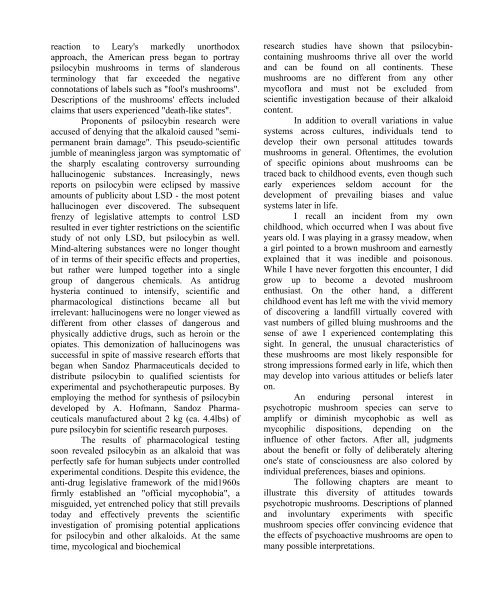Jochen Gartz - Magic Mushrooms Around the ... - preterhuman.net
Jochen Gartz - Magic Mushrooms Around the ... - preterhuman.net
Jochen Gartz - Magic Mushrooms Around the ... - preterhuman.net
You also want an ePaper? Increase the reach of your titles
YUMPU automatically turns print PDFs into web optimized ePapers that Google loves.
eaction to Leary's markedly unorthodox<br />
approach, <strong>the</strong> American press began to portray<br />
psilocybin mushrooms in terms of slanderous<br />
terminology that far exceeded <strong>the</strong> negative<br />
connotations of labels such as "fool's mushrooms".<br />
Descriptions of <strong>the</strong> mushrooms' effects included<br />
claims that users experienced "death-like states".<br />
Proponents of psilocybin research were<br />
accused of denying that <strong>the</strong> alkaloid caused "semipermanent<br />
brain damage". This pseudo-scientific<br />
jumble of meaningless jargon was symptomatic of<br />
<strong>the</strong> sharply escalating controversy surrounding<br />
hallucinogenic substances. Increasingly, news<br />
reports on psilocybin were eclipsed by massive<br />
amounts of publicity about LSD - <strong>the</strong> most potent<br />
hallucinogen ever discovered. The subsequent<br />
frenzy of legislative attempts to control LSD<br />
resulted in ever tighter restrictions on <strong>the</strong> scientific<br />
study of not only LSD, but psilocybin as well.<br />
Mind-altering substances were no longer thought<br />
of in terms of <strong>the</strong>ir specific effects and properties,<br />
but ra<strong>the</strong>r were lumped toge<strong>the</strong>r into a single<br />
group of dangerous chemicals. As antidrug<br />
hysteria continued to intensify, scientific and<br />
pharmacological distinctions became all but<br />
irrelevant: hallucinogens were no longer viewed as<br />
different from o<strong>the</strong>r classes of dangerous and<br />
physically addictive drugs, such as heroin or <strong>the</strong><br />
opiates. This demonization of hallucinogens was<br />
successful in spite of massive research efforts that<br />
began when Sandoz Pharmaceuticals decided to<br />
distribute psilocybin to qualified scientists for<br />
experimental and psycho<strong>the</strong>rapeutic purposes. By<br />
employing <strong>the</strong> method for syn<strong>the</strong>sis of psilocybin<br />
developed by A. Hofmann, Sandoz Pharmaceuticals<br />
manufactured about 2 kg (ca. 4.4lbs) of<br />
pure psilocybin for scientific research purposes.<br />
The results of pharmacological testing<br />
soon revealed psilocybin as an alkaloid that was<br />
perfectly safe for human subjects under controlled<br />
experimental conditions. Despite this evidence, <strong>the</strong><br />
anti-drug legislative framework of <strong>the</strong> mid1960s<br />
firmly established an "official mycophobia", a<br />
misguided, yet entrenched policy that still prevails<br />
today and effectively prevents <strong>the</strong> scientific<br />
investigation of promising potential applications<br />
for psilocybin and o<strong>the</strong>r alkaloids. At <strong>the</strong> same<br />
time, mycological and biochemical<br />
research studies have shown that psilocybincontaining<br />
mushrooms thrive all over <strong>the</strong> world<br />
and can be found on all continents. These<br />
mushrooms are no different from any o<strong>the</strong>r<br />
mycoflora and must not be excluded from<br />
scientific investigation because of <strong>the</strong>ir alkaloid<br />
content.<br />
In addition to overall variations in value<br />
systems across cultures, individuals tend to<br />
develop <strong>the</strong>ir own personal attitudes towards<br />
mushrooms in general. Oftentimes, <strong>the</strong> evolution<br />
of specific opinions about mushrooms can be<br />
traced back to childhood events, even though such<br />
early experiences seldom account for <strong>the</strong><br />
development of prevailing biases and value<br />
systems later in life.<br />
I recall an incident from my own<br />
childhood, which occurred when I was about five<br />
years old. I was playing in a grassy meadow, when<br />
a girl pointed to a brown mushroom and earnestly<br />
explained that it was inedible and poisonous.<br />
While I have never forgotten this encounter, I did<br />
grow up to become a devoted mushroom<br />
enthusiast. On <strong>the</strong> o<strong>the</strong>r hand, a different<br />
childhood event has left me with <strong>the</strong> vivid memory<br />
of discovering a landfill virtually covered with<br />
vast numbers of gilled bluing mushrooms and <strong>the</strong><br />
sense of awe I experienced contemplating this<br />
sight. In general, <strong>the</strong> unusual characteristics of<br />
<strong>the</strong>se mushrooms are most likely responsible for<br />
strong impressions formed early in life, which <strong>the</strong>n<br />
may develop into various attitudes or beliefs later<br />
on.<br />
An enduring personal interest in<br />
psychotropic mushroom species can serve to<br />
amplify or diminish mycophobic as well as<br />
mycophilic dispositions, depending on <strong>the</strong><br />
influence of o<strong>the</strong>r factors. After all, judgments<br />
about <strong>the</strong> benefit or folly of deliberately altering<br />
one's state of consciousness are also colored by<br />
individual preferences, biases and opinions.<br />
The following chapters are meant to<br />
illustrate this diversity of attitudes towards<br />
psychotropic mushrooms. Descriptions of planned<br />
and involuntary experiments with specific<br />
mushroom species offer convincing evidence that<br />
<strong>the</strong> effects of psychoactive mushrooms are open to<br />
many possible interpretations.








![The Big Lie 9-11 and Government Complicity in Mass Murder [PDF]](https://img.yumpu.com/50957077/1/190x245/the-big-lie-9-11-and-government-complicity-in-mass-murder-pdf.jpg?quality=85)








